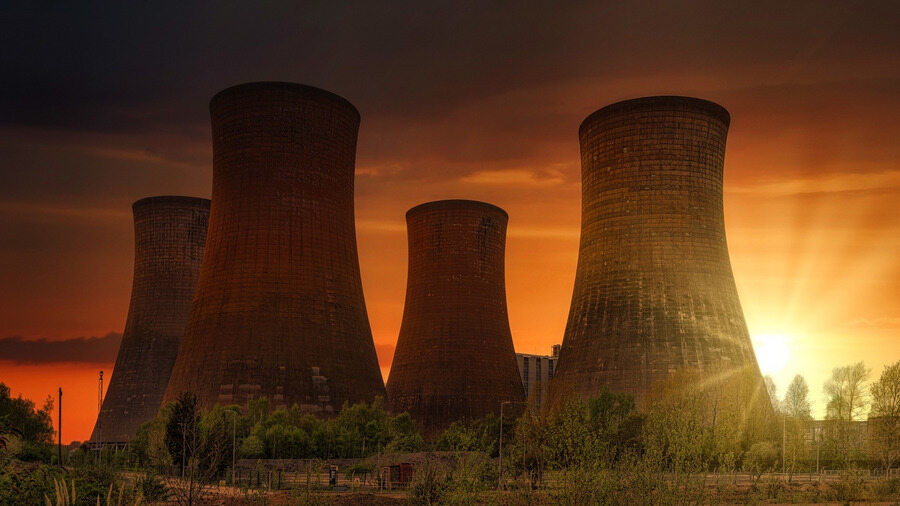A cooling tower is a heat rejection device that removes waste heat from a power plant to the atmosphere.
It works by cooling down hot water that has been used in the plant's systems. Once the water is cooled, it's reused in the system for heat absorption, forming a continuous cycle.
In essence, the cooling tower acts like the lungs of the power plant — ensuring heat is expelled effectively so that operations can continue safely and efficiently.
Why Are Cooling Towers Important in Power Plants?
Power plants, especially thermal power stations, generate a tremendous amount of heat during electricity production. While part of this heat is used to generate steam for turbines, the remainder is waste heat that must be removed from the system.
If this heat isn't dissipated properly:
-
Equipment can overheat and fail.
-
The efficiency of the plant drops.
-
Environmental regulations may be violated.
Cooling towers provide an environmentally friendly, cost-effective method to discharge this heat without polluting nearby water bodies.
How Does a Cooling Tower Work?
The basic working principle of a cooling tower is evaporative cooling. Here's a simplified breakdown:
-
Hot Water Enters: Heated water from the plant (usually from the condenser) enters the cooling tower.
-
Water Distribution: The water is spread across fill material to increase surface area and slow down its flow.
-
Air Movement: Air (natural or forced) flows upward or across the water, encouraging evaporation.
-
Heat Transfer: As some of the water evaporates, it takes heat away from the remaining water.
-
Cooled Water Collection: The now-cooled water collects at the bottom basin and is pumped back into the plant system.
-
Blowdown & Makeup Water: Some water is lost due to evaporation and drift, so fresh water (makeup) is added while a portion is drained (blowdown) to control mineral buildup.
Types of Cooling Towers
Cooling towers can be classified based on several factors:
1. Based on Air Flow Mechanism
a. Natural Draft Cooling Tower
-
Uses the natural convection of air.
-
Tall, hyperbolic structure (iconic shape).
-
Common in nuclear and large thermal plants.
-
Low operating cost but high capital investment.
b. Mechanical Draft Cooling Tower
-
Uses fans to force or draw air through the tower.
-
Suitable for small to medium-sized facilities.
There are two subtypes:
-
Forced Draft: Fans at the air inlet push air in.
-
Induced Draft: Fans at the air outlet pull air through.
c. Hybrid Draft Cooling Tower
-
Combines both natural and mechanical systems.
-
Balances energy efficiency with performance.
2. Based on Heat Transfer Method
a. Wet Cooling Tower
-
Relies on evaporative cooling.
-
Water and air are in direct contact.
-
Highly efficient, but consumes water.
b. Dry Cooling Tower
-
Uses air-cooled heat exchangers.
-
No water loss; more environmentally sustainable.
-
Less efficient and more expensive to operate.
c. Wet-Dry (Hybrid) Cooling Tower
-
Combines both methods to optimize water use and cooling efficiency.
-
Common in regions with water scarcity.
3. Based on Water Flow Design
a. Counterflow Cooling Tower
-
Water flows downward while air flows upward.
-
Compact design; more efficient cooling.
-
Requires higher fan power.
b. Crossflow Cooling Tower
-
Air flows horizontally, water flows downward.
-
Easier maintenance and lower fan power requirement.
-
Larger footprint.
Design Considerations for Cooling Towers
Designing an effective cooling tower for a power plant involves multiple factors:
1. Thermal Performance
The cooling tower must meet the plant’s cooling load, which is determined by:
-
Heat rejection requirement (MW or tons).
-
Temperature range: Difference between hot and cooled water.
-
Wet bulb temperature: A critical environmental condition.
2. Material Selection
Common materials include:
-
FRP (Fiberglass Reinforced Plastic): Lightweight, corrosion-resistant.
-
Concrete: Durable, suitable for large installations.
-
Galvanized Steel: Affordable but prone to corrosion.
3. Drift Eliminators
These prevent water droplets from escaping into the atmosphere, reducing water loss and minimizing environmental impact.
4. Fill Media
The fill increases surface area for air-water contact.
-
Splash Fill: Breaks water into droplets.
-
Film Fill: Spreads water into a thin film. More efficient but can clog in dirty environments.
5. Fan and Motor System
Mechanical towers require high-efficiency fans and motors. Energy consumption here significantly impacts operating costs.
6. Noise Control
Especially in urban or sensitive environments, noise-reducing fans and silencers are important.
7. Environmental Regulations
Cooling towers must comply with:
-
Water usage limits.
-
Emissions control (drift, plume).
-
Legionella risk mitigation (bacterial control).
Advantages of Cooling Towers in Power Plants
-
Improved Thermal Efficiency: Keeps turbines and condensers at optimal temperatures.
-
Water Conservation: Recirculates water instead of continuous withdrawal from natural sources.
-
Cost-Efficient: Mechanical towers are economical to operate.
-
Space Efficient: Especially with vertical flow towers.
-
Environmentally Safer: Prevents thermal pollution of rivers or lakes.
Disadvantages and Challenges
-
Water Loss: Evaporation and drift can lead to significant water usage.
-
Scaling and Fouling: Hard water can lead to mineral buildup.
-
Noise: Mechanical components can generate considerable sound.
-
Initial Capital Cost: Especially for natural draft towers.
-
Biological Risks: Warm, moist environments can encourage microbial growth like Legionella.
Conclusion
Cooling towers are an indispensable part of power plant operations. Their ability to efficiently remove heat not only protects equipment but also ensures sustainable operation in a world where energy demand and environmental awareness are rising.
By understanding the function, types, and design aspects of cooling towers, engineers and plant managers can make informed decisions to enhance performance, reduce costs, and minimize environmental impact.
Whether you're designing a new plant or optimizing an existing one, the right cooling tower choice can significantly influence operational success.

